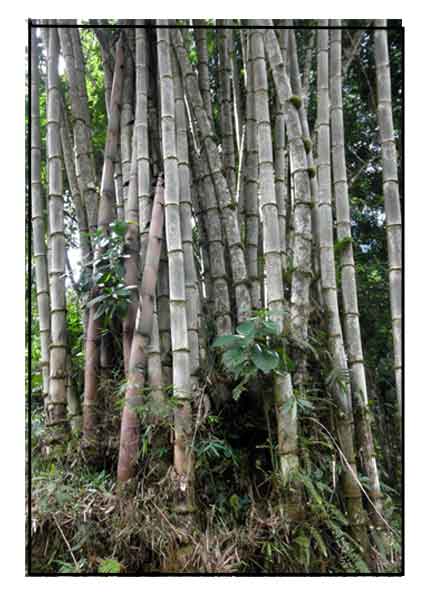 Botany Botany
Gigantochloa levis is a densely tufted, sympodial bamboo. Culm is erect, up to 20 m tall, diameter up to 16 cm or slightly more, plain green; nodes not conspicuously swollen; internodes up to 45 cm long, densely dark-hairy all over at the base of the culm, scattered dark-hairy on the upper parts, without any conspicuous white waxiness. Branches at each midculm node arise from a single bud with one subdominant secondary branch from the base on each side, and several lesser leafy branches from the base of secondary branches. Culm sheath broadly triangular, 10-34 cm long, pale to medium green, with dark grown hairs on the back. Young shoot slightly triangular in outline, brown-green to green, covered with dark brown hairs, with green lips. Leaf blade 8-35 cm x 2-7 cm, lower surface short pale-hairy. Inflorescences, usually on leafless culms, consist of puberulent long branches with clusters of up to 75 pseudo-spikelets at the nodes, the clusters 1,5-12 cm apart; pseudo-spikelets 10-12 mm long, with 2-3 gemmiferous bracts, 2-3 glumes, 4-5 perfect florets and a vestigial terminal floret. (3)
Distribution
- Introduced.
- Cultivated; naturalized to a certain extent.
- Native range is China to Vietnam, Malesia.
Constituents
- Chemical composition of mature culms on dry weight basis yields approximately 63% hemicellulose, 19% pentosans, 24% lignin, 5.3% ash, and 2,8% silica. (3)
- 100 g of edible portion of young shoots ( 7-14 days old) yield approximately 87 g water, 3 g protein, 7 g fat, 0 g carbohydrate, 1.5 g fiber, 1 g ash, 20 mg calcium, 27 mg phosphorus, 1 mg iron, 0.07 mg thiamine, and 4 mg vitamin C. (3)
- Proximate analysis of air-dried bolo leaves yielded 11.4% moisture, 15.8% ash, 22.6% crude protein, 1.2% crude fat, and 29.3% crude fiber. Total sugar was 19.7% by difference. Phytochemical screening yielded diterpenes, triterpenes, saponins, phenols, tannins, and flavonoids in both ethanol and aqueous leaf extracts, with phytosterols detected only in the ethanolic extract. Foilin-Ciocalteu tests showed the total phenolic content in gallic acid equivalent (GAE) to be 85.86 ± 3.71 mg GAE/100g died sample for the ethanolic extract and 32.32 ± 1.01 mg GAE/100g dried sample for the aqueous extract. Total phenolic content in quercetin equivalent (QE) was 74.44 ± 3.11 and 29.43 ± 0.85 mg QE/100g dried sample for ethanolic and aqueous extracts, respectively.
(see study below) (5)
- Elemental analysis of ash of bolo leaves showed Si as the major component at 74.48 ± 0.18%, followed by K and Mg at 9,60 ± 0,11% and 7.06 ± 0.21%, respectively.
(see study below) (5)
-
Properties
- Studies have suggested nutrient, probiotic, and antioxidant properties.
Parts used
Stems, leaves, shoots.
Uses
Edibility
- Yield an edible shoot.
Folkloric
- Juice from stem drunk for fever.
Others
- Construction: Culms used as framework in rough house construction; split for planting walls. In the - Crafts: One of the bamboo species used in the handicraft industry. in the Philippines, modern furniture crafted from the culms. In Sabah, used as temporary water pipes, for fencing and bathing platforms beside rivers (3)
- Fishing: Culms used for making rafts, fish traps, -outriggers and fish pens.
Studies
• Prebiotic Activity of Polysaccharides / Shoots: Bamboo shoots yielded crude polysaccharides 4.27 ± 0.18% on dry weight basis with minute percentage of protein (0.02 ± 0.01%). The FTIR spectrum of bamboo shoot crude polysaccharides (BSCP) revealed likely presence of ß-glucan, which can be considered a valuable compound for medical and food industries. The BSCP has a resistance towards artificial gastric juice which is more than 99%. Prebiotic activity testing using BSCP as carbon source showed significant increase in growth of B. animalis, B. longum and L acidophilus. Results suggest a potential for the BSCP as a promising prebiotic. (4)
• Antioxidant / Leaves: Study evaluated aid-dried bolo leaves for elemental, nutritional, and phytochemical composition and antioxidant activity. The ethyl acetate and n-butanol fractions showed highest antioxidant activity by DPPH assay. Results showed bolo leaves to have potential as source of minerals and bioactive compounds with medicinal value. (see constituents above) (5)
Availability
- Cultivated.
- Wildcrafted.
|

![]()




